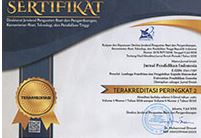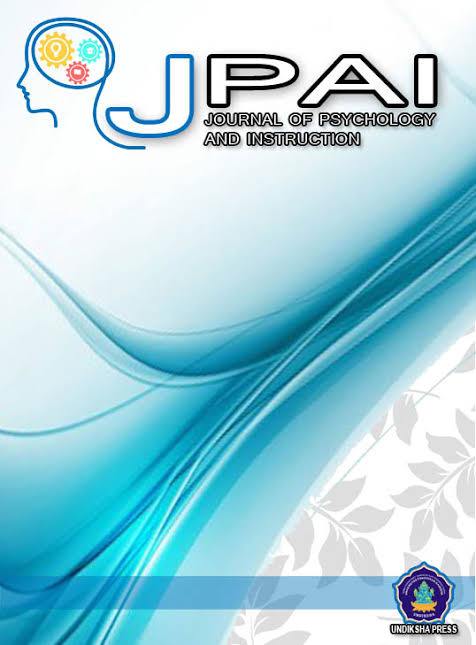The Implementation of Inclusive Education by English Teachers to Teach Slow Learners at SMK Negeri 3 Singaraja
DOI:
https://doi.org/10.23887/jpai.v3i1.20894Keywords:
inclusive education, slow learner, teaching englishAbstract
Inclusive education has been increasing significantly in Singaraja and helping the students with special needs as well as getting their right to have a proper education. Since inclusive was a new policy in education, new research was needed to find out how the implementation and the obstacles faced in inclusive. This study was aimed at investigating the implementation of inclusive education by English teachers to teach slow learners included in a regular classroom. This research was conducted at SMK Negeri 3 Singaraja as one of the general schools which implemented inclusive education. This research was in the form of qualitative research with a case study method. The data were obtained through document study, interviews, and observations. The findings show that (1) the English teachers used same teachers' preparation and modified some activities in the learning process and used different assessment, and (2) there were also found supporting factors such as complete administration, a good way of transferring knowledge, used different assessment and also found challenging factors in implementing inclusive education such as lack of trained teacher, lack of inclusive policy, and lack of differentiation in instructions. Inclusive education has been implemented at SMK Negeri 3 Singaraja but still has to be improved.
References
Ali, N., Anwer, M., & Abbas, J. (2015). Impact of peer tutoring on learning of students. Journal for Studies in Management and Planning, 1 (2), 61-66.
Amelia, W. (2016). Characteristics and type of learning difficulties of student with slow learner. Jurnal Ilmu Kesehatan Aisyah, 1 (2), 53-58. DOI: https://doi.org/10.30604/jika.v1i2.21
Ametepee, K., & Anastasiou, D. (2015). Special and Inclusive Education in Ghana: Status and Progress, Challenges and Implications. International Journal of Education Development , 143-152. DOI: https://doi.org/10.1016/j.ijedudev.2015.02.007
Anyanwu, S. U. (2015). Student-centered teaching and learning in higher education: Transition from theory to practice in Nigeria. International Journal of Education and Research, 3 (8), 349-358.
Aziz, A. N., Sugiman, & Prabowo, A. (2015). Analisis proses pembelajaran matematika pada anak berkebutuhan khusus (ABK) slow learner di kelas inklusif SMP Negeri 7 Salatiga. Jurnal Matematika Kreatif-Inovatif, 6 (2), 111-120. DOI: https://doi.org/10.15294/kreano.v6i2.4168
Bahrudin. (2018). Pendidikan Slow Learner dalam Setting Pendidikan inklusif . In Bahan Ajar Bimbingan Teknis Pembelajaran Siswa Berkebutuhan Khusus bagi Guru SMA-SMK Penyelenggara (pp. 167-174). Jakarta: Kementerian Pendidikan dan Kebudayaan Republik Indonesia .
Bhardwaj, A. (2016). Importance of education in human life: A holistic approach. International Journal of Science and Consciousness ,2(2) 23-28.
Bhatnagar, N., & Das, A. (2014). Regular School Teachers’ Concerns and Perceived Barriers to Implement Inclusive Education in New Delhi, India. International Journal of Instruction, 7 (12), 90-102.
Borah, R. R. (2013). Slow learners: Role of teachers and guardians in honing their hidden skills. International Journal of Educational Planning & Administration, 3 (2), 139-143 .
Buyukalan, S. F., & Altiny, Y. B. (2018). Views of primary teachers about homework (A qualitative analysis). Journal of Education and Training Studies, 6 (9), 152-162. DOI: https://doi.org/10.11114/jets.v6i9.3382
Chamidah, A. N. (2016). Deteksi dini gangguan pertumbuhan dan perkembangan anak. Jurnal Pendidikan Khusus, 5 (2), 83-93.
Dewi, N. (2017). Developing differentiated electronic supplementary reading exercise for the slow learners of seventh year students at SMP N 2 Singaraja. International Journal of Language and Literature, 1 (1), 30-41. DOI: https://doi.org/10.23887/ijll.v1i1.9616
Faravani, A., Zeraatpishe, M., Azarnoosh, M., & Kargozari, H. R. (2018). Issues in syllabus design. Netherlands: Sense Publishers. DOI: https://doi.org/10.1163/9789463511889
Fitri, D. A., Rusdiyani, I., Maemunah, T., Miharja, M. H., & Putri, H. A. (2018). Meningkatkan kemampuan menulis dengan metode drill bagi siswa yang terindikasi berkesulitan belajar. Jurnal Dimensi Pendidikan dan Pembelajaran, 6 (2), 60-63. DOI: https://doi.org/10.24269/dpp.v6i2.1014
Forlin, C., & Chambers, D. (2011). Theacher preparation for inclusive education: Increasing knowledge but raising concerns. Asia-Pasific JPurnal of Teacher Education, 39 (1), 17-32. DOI: https://doi.org/10.1080/1359866X.2010.540850
Ganske, K. (2017). Lesson closure: An important piece of the student learning puzzle. International Literacy Association, 71 (1), 95–100 . DOI: https://doi.org/10.1002/trtr.1587
Hackathorn, J., Solomon, E. D., & Blankmeyer, K. L. (2011). Learning by doing: An empirical study of active teaching techniques. The Journal of Effective Teaching, 11 (2), 40-54. DOI: https://doi.org/10.1037/e683152011-599
Hartini, A., Widyaningtyas, D., & Mashluhah, M. I. (2017). Learning strategies for slow learners using the project based learning model in primary school.Jurnal Pendidikan Inklusi, 1 (1), 29-39. DOI: https://doi.org/10.26740/inklusi.v1n1.p29-39
Herlina, F. (2014). Meningkatkan kemampuan membaca kata melalui media audio vidual bagi anak slow learner. Jurnal Ilmiah Pendidikan Khusus, 3 (3), 53-63.
Ho, D. T., &Intai, R. (2017). Effectiveness of audio-visual aids in teaching lower secondary science in a rural secondary school. Asia Pacific Journal of Educators and Education, 32, 91–106. DOI: https://doi.org/10.21315/apjee2017.32.7
Holmberg, J. B., & Jeyaprathaban, S. (2016). Effective Practice in Inclusive and Special Needs Education. International Journal of Special Education, 31 (1), 119-134.
Johan, R., & Harlan, J. (2014). Education nowadays. International Journal of Educational Science and Research, 4 (5), 51-56.
Kaushik, M., & Sankar, B. G. (2017). The challenges and opportunities to implement inclusive education in West Bengal. International Journal of Humanities and Social Science Invention (IJHSSI), 6 (12), 38-43.
Kavelashvili, N. (2017). Inclusive Education in Georgia: Current Progress and Challenges . Challenges of the Future , 89–101.
Kumar, M., Shambhu, S., & Aggarwal, P. (2016). Recognition of slow learner using classification data mining techniques. Imperial journal of interdisciplinary research, 2 (12), 741-747.
Kustawan, D. (2018). Kurikulum, pembelajaran, dan penilaian dalam setting pendidikan inklusif . In Bahan Ajar Bimbingan Teknis Pembelajaran Siswa Berkebutuhan Khusus bagi Guru SMA-SMK Penyelenggara Pendidikan (pp. 17-59). Jakarta: Kementerian Pendidikan dan Kebudayaan Republik Indonesia .
Mapolisa, T., & Tshabalala, T. (2013). The impact of inclusion of children with hearing impairment into regular schools: A case study of Dakamela Primary School in Zimbabwe. International Journal of Asian Social Science , 6 (2), 1500-1510.
McCrimmon, A. W. (2015). Inclusive education in Canada: Issues in teacher preparation. Intervention in School and Clinic, 50 (4), 234-237. DOI: https://doi.org/10.1177/1053451214546402
Mitiku, W., Alemu, Y., & Mengsitu, S. (2014). Challenges and opportunities to implement inclusive education. Asian Journal of Humanity, Art and Literature, 1 (2), 118-136. DOI: https://doi.org/10.15590/ajhal/2014/v1i2/54051
Muhammad, I. (2013). Diferensi makna kurikulum di Indonesia. Jurnal Mudarrisuna, 3 (2), 282-294.
Mukunthan, T. (2013). A study on students’ errors on word problem. Research Gate, 3 (10), 205-214.
NICHCY. (2012). Categories of Disability Under IDEA. National Dissemination Center for Children with Disabilities , 1-6.
Padmadewi, N. N., & Artini, L. P. (2017). Teaching english to a student with autism spectrum disorder in regular classroom in Indonesia. International Journal of Instruction, 10 (3), 159-176. DOI: https://doi.org/10.12973/iji.2017.10311a
Pandey, S., & Kurian, B. J. (2016). An Effective way to deal with slow learners: Positive response teaching. Journal of Research & Method in Education, 6 (6), 19-22.
Puteri, L. H. (2018). The apperception approach for stimulating student learning motivation. International Journal of Education, Training and Learning, 2 (1), 7-12. DOI: https://doi.org/10.33094/6.2017.2018.21.7.12
Ruhela, R. (2014). The pain of the slow learners. Online International Interdisciplinary Research Journal, 4 (4), 139-200.
Sequeira, A. H. (2017). Introduction to concepts of teaching and learning . ResearchGate , 1-7.
Shabiralyani, G., Hasan, K. S., Hamad, N., & Iqbal, N. (2019). Impact of visual aids in enhancing the learning process case research: District Dera Ghazi Khan.Journal of Education and Practice, 6 (19), 226-233.
Sharma, A. (2015). Perspectives on inclusive education with reference to united nations.Universal Journal of Educational Research, 3 (5), 317-321. DOI: https://doi.org/10.13189/ujer.2015.030502
Singh, J. (2016). Inclusive education in India – Concept, need and challenges. Scholarly Research Journal for Humanity Science & English Language, 3 (13), 3222-3232.
Suh, H. (2011). Collaborative learning models and support technologies in the future classroom. International Journal for Educational Media and Technology, 5 (1), 50-61 .
Sundari, H., Rafli, Z., & Ridwan, S. (2017). Interaction patterns in english as foreign language classroom at lower secondary schools. Journal of English Education, 6 (1), 99-108. DOI: https://doi.org/10.25134/erjee.v6i1.775
Tyagi, G. (2016). Role of teacher in inclusive education. InternatIonal Journal of Education and Applied Research, 6 (1), 115-116.
Undang-undang No.20 Tahun 2003 Pasal 15
Undang-undang Dasar Pasal 31 Ayat 1
Vasudevan, A. (2017). Slow learners – Causes, problems and educational programmers. International Journal of Applied Research, 3 (12), 308-313.
Williamson, J., & Paul, J. (2012). The “slow learner” as a mediated construct. Canadian Journal of Disability Studies, 1 (3), 91-128. DOI: https://doi.org/10.15353/cjds.v1i3.59
Yusuf, M. (2018). Pendidikan anak berkebutuhan khusus. In Bahan Ajar Bimbingan Teknis Pembelajaran Siswa Berkebutuhan Khusus bagi Guru SMA-SMK Penyelenggara Pendidikan (pp. 4-11). Jakarta: Kementerian Pendidikan dan Kebudayaan Republik Indonesia. DOI: https://doi.org/10.14421/jpai.2014.112-05










